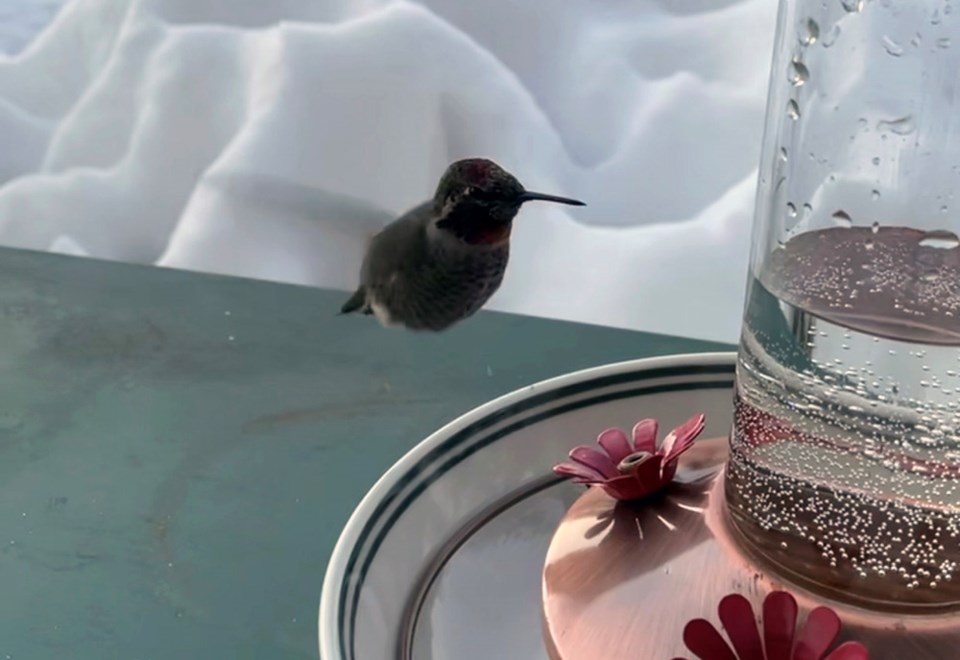Keep your hummingbird feeder warm because slushy or frozen nectar can do more harm than good, says the Wildlife Rescue Association.
Volunteers have been busy responding to calls about the tiny, winged household visitor since an arctic outflow warning has descended on B.C., including the Tri-Cities.
Common winter injuries include frostbitten and damaged tongues, injury from fighting rivals for access to limited food supplies, hypothermia (frozen to feeders or other structures, and dropped to the ground), and hypoglycemia (low blood sugar, from not consuming enough calories).
One of the biggest problems is frozen feeding tubes but hummingbirds can also get stuck to the feeder or pass out from the cold and land in the snow.
Watch for injuries to birds from cold
Fortunately, many of these injuries can be prevented through proper feeder care, according to the association.
Taylor Martin, communications spokesperson for the rescue association, said people calling in during the current cold snap are most concerned about hummingbirds and varied thrushes, which stick around in the winter and spend time on the ground.
"Sometimes birds just need a break from the cold," said Martin.
However, the association warns against warming up birds too quickly because it could put them into shock while the best way to pick up a bird is to scoot it into a well-ventilated box, with the addition of a paper towel or low-pile towel at the bottom of the box.
Keep the bird in a cool garage to allow them to regain their warmth rather than a heated spot, Martin said, and release them when they appear revived.
"If the bird looks OK, it’s OK to send it out again," said Martin.
As for safe winter feeding of hummingbirds, it's important to ensure their nectar is heated. Additional information about Arctic outflows impacts on hummingbrids can be found on the association's website.
If you have questions or doubts about what to do, call the help line at 604-526-7275 or email [email protected].
@tricitynews Clean your feeders. 🐦🙏 #tricitynews #coquitlam #hummingbird #birdfeeder ♬ original sound - TriCityNews
Hummingbirds have to eat a lot
Weighing less than a loonie, hummingbirds require significant amounts of food to keep flapping their tiny wings to 50 times or more per second, according to information on the Wildlife Rescue Association's website.
While most hummingbirds fly south for the winter, except for a few stragglers, the Anna’s Hummingbird stays on the Pacific coast year-round.
How they stay alive during a cold winter's night is by going into a state of 'torpor,' where their heart rate and body temperature decreases.
"Yet even during torpor, a hummingbird’s metabolism is so high, they will lose around 10% of their body weight overnight. To deal with the scarcity of nectar, hummingbirds tend to eat more insects over the winter," the website states.
Hummingbird feeders also help to fill in the gap.
However, they must be cleaned often. The BC SPCA is warning people to clean humming bird feeders frequently due to a risk of spreading Avian flu.
Bird feeders that attract multiple types of birds should be taken down, however, due to rhe risk of birds getting sick, the BC SPCA said in a recent statement.
Keep hummingbird feeders from freezing
Here are a few tips from the Wildlife Rescue Association to keep your hummingbird feeders from freezing.
- Purchase or make a feeder heater to use when temperatures drop below zero
- Get a couple of feeders, keep one inside and alternate them when the ice starts to form.
- Keep your feeders clean – change out the solution and thoroughly scrub the feeder every few days at minimum
- Use a plastic feeder with no metal parts
- Create a warming zone, protected from wind and snow
- Remember that the most important part of the feeder to keep liquid (thawed) is the entrance/channel to the feeding tubes; this is where the tongue injuries occur when they freeze to the feeder
How did your hummingbirds fare over the latest cold snap?
We'd love to see your photos and videos. Send them, plus an address and other relevant information, to [email protected].





